|
|
|
Half of the month of February had passed into history before Task Force Ward struck its opening blows at the great barrier that separated liberated Europe from the Nazi homeland. The initial move brought the Task Force into Hupperdange at which point our infantrymen dismounted to proceed on foot into Kalborn, where the Battalion Command Post was established. Following a reconnaisance mission led by Lieutenant Kirk and Lieutenant Palumbo, Commanders of "A" and "C" Companies respectively, our troops advanced across the Our River to set foot on German soil, where heavy concentration of artillery and mortar fire from still potent German guns greeted our arrival.
Vicious as was the enemy resistance, the Task Force held a firm grip on its first slice of German territory. With the emphasis on defense for the moment, our troops held positions on the Southeast edge of Wald Wehrbusch, while still under a continuous rain of German artillery. Meanwhile, Company "B" replaced Lieutenant Kirk's men in position. This had hardly been accomplished when the enemy launched a savage counterattack in the sector occupied by Company "C". To off-set this situation two platoons out of "A" Company were immediately called back to strengthen those lines. Despite the fact that his attack was supported by an extremely heavy artillery barrage, the now reinforced "C" Company lines not only held firm, but crushed the attack For gallantry in action, Staff Sergeant Clair O. Parsons, Service Company, was awarded the Silver Star. During the period from 26 February to 28 February he aided the advance of the Battalion across the Pram River near Lunebach, personally reconnoitering river crossings, and stringing wire in advance of the assault troops with insured perfect communications during the entire operation. Later, with complete disregard for enemy fire, he worked tirelessly evacuating wounded members of this Battalion. completely, suffering only light casualities in this first major engagement fought by our troops on the Nazi home grounds. |
|
A CONCRETE FACT 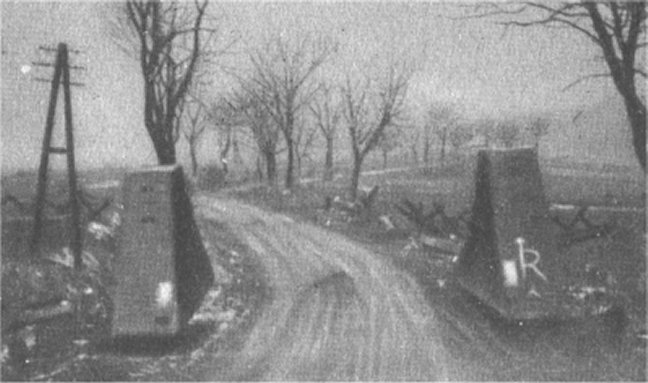
HIT THAT LINE, SOLDIER .... Our Battalion did just that, up near DasBurg. This little mission became Colonel Ward's headache almost as soon as he walked into the Battalion Command Post on February 7, 1945 and assumed Command of the Battalion, replacing Major Paul C. Root Jr., who'd carried on following Colonel Wall's evacuation. |
|
Two days now passed with no noticable change taking place, although the Task Force did succeed in securing our flanks with other friendly elements, all accomplished under continued harrassing enemy fire. As "A" Company relieved "C" Company on line, friendly artillery opened up on the German positions, taking a heavy toll of Nazi lives and destroying a number of enemy mortar and machine gun positions.
Subsequently Task Force Ward was relieved by Task Force Brown, after which our troops moved into the villa of Donnange to benefit from a short rest period. Refreshed by those few days of comparative idleness, our Battalion was joined by a Company of tanks, a platoon of Tank Destroyers and a Platoon of Engineers. Task Force Ward moved out of Donnange and proceeded to an Assembly Area in the vicinity of Heinersheid, prepared to attack to the East on order. That order was not long in coming, and daylight the following day saw Task Force Ward rumbling toward its new objectives, the towns of Reipeldingen and Daleiden. In a "blitz-like" attack, carried out in typical tank-infantry style, Companies "B" and "C" soon enveloped Reipeldingen before the enemy had time to organize any more than the weakest sort of resistance. Daleiden on the other hand presented a much more difficult problem. Therefore, when a mounted attack appeared to be too dangerous, the same two Companies that had previously occupied Reipeldingen, dismounted and after a bitter struggle that lasted until mid-afternoon battered their way into Daleiden, clearing it of all enemy troops. Our Battalion had now forced its way far enough into the Seigfried defenses to take advantage of some of its positions for our own use. After outposting Daleiden, the Battalion Command Post was established in an huge pill box only recently vacated by the master race. The long famed, and so-called impregnable Seigfried Line was crumbling under the pressure of our advance and cracking under the blows rained upon it by other American Forces to the North and South. Company "C" moved down out of Reipeldingen during the night and, with other elements of Task Force Ward, established a perimeter defense around Daleiden in preparation for an attack to be opened at dawn of February 22nd. This day was marked by a series of fierce skirmishes against some of the most determined opposition encountered since the start of our missions in the Battle of the Bulge. Despite this, and despite heavy enemy artillery fire, our troops forced a bridgehead across the Irsem River and by nightfall Olmsheid was cleared by a Platoon from Company "B". Whatever difficulties might have been encountered along our left flank were soon solved by "A" Company, which pushed its way through vicious pockets of resistance to tie in with lines held by the 44th Armored Infantry Battalion. Barring any immediate advance now was a heavily wooded area approximately one mile from Daleiden, an area that proved itself to be a veritable hornet's nest of Nazi tank and infantry forces. Realizing that a direct assault upon the enemy at this point would prove a costly venture, Colonel Ward choose to by pass the area, then wheel suddenly and launch his attack. This bold course of action caught the enemy completely by surprise, with the result that the woods were speedily cleared against unexpectedly light resistance. When "A" and "C" Companies launched an attack that night they soon reached two prominent hills dominating the Irsen River near Bourenmourt, an area that immediately came under their control. In a series of powerful thrusts, our troops overcame all remaining resistance and readied Lunebach, where combat patrols from "C" Company probed the defenses of that town without meeting the heavy opposition that was expected. In the light of experiences during the week just passed, there was no reason to believe that this town would present any great difficulty, yet Lunebach was to become a village of death. The severest casualties came from cunningly concealed booby traps, which in turn attracted a terrific enemy artillery barrage. Despite heavy losses and fanatic opposition, our troops cleared Lunebach and the immediate vicinity in a drive that carried Task Force Ward across the icy cold Prum River. The last two days of February were marked by a continuous hail of fire poured into our positions, which eventually forced our withdrawl to the original lines West of the Prum. The set-back was merely temporary however, and at dawn on the last day of February, the Task Force mounted a second attack that brought it across the Prum, this time to stay. Even before our troops had completed the defense work around the bridgehead thus established, Engineers attadied to the Task Force began the construction of a Baily Bridge over which the attack was continued to the East. February became March, and the slow tortuous advance |
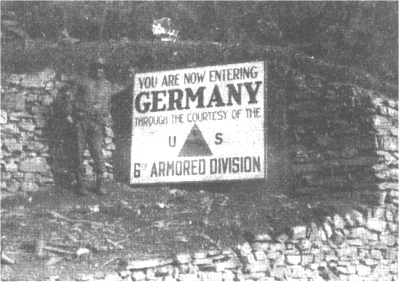
T-H-I-S W-A-Y P-L-E-A-S-E An Officer of our Battalion stands beside a "welcome" sign on Germany's doorstep. Our troops were among the first of the Division to enter the Nazi strong hold through the Siegfried Linie at Dasburg. A second entry trough the vaunted West Wall was later made in the Sarre Unione Area. |
|
continued along the Prum. Large scale resistance in our sector had ceased, and only small but vicious strong-points momentarily blocked our relentless progress through the soon to be pulverized Siegfried Line.
The new month brought with it clear dry weather, and now the full power of our Armor could blast gaping holes in the enemy's renowned fortifications. Much fighting was to be done, but victory was close now; our troops could sense it, almost feel it, giving them the extra energy and stamina necessary to battle on night and day. Our troops fought, ate and slept in their Half Tracks and tanks. The enemy was not to be allowed time for even the smallest reorganization. Germany's once powerful armies were now on the run, and the rocket of Hitler's ascendency to European domination was falling fast. On that first day of March 1945, Task Force Ward began to expand its bridgehead along the Prum River, and advanced to the high ground Northwest of Matzerath, meeting only moderate resistance along the route. But heavy concentrations of artillery fire forced elements of the 86th Calvary Reconnaisance Squadron back to their original positions, leaving our own northern flank completely exposed and vulnerable to attack. Task Force Ward met this threat by moving into position at the north edge of a woods perpendicular to the line held by our own Battalion and that of the 86th Reconnaisance. A sweeping advance led by Company "B" swung the left flank arround to face Matzerath from the Northwest. That sharp, swift maneuver not only removed the danger of any ''strong counterattack, but secured the Task Force's objective, for Matzerath fell to our troops late that afternoon. Except for intermittent artillery, our sector was inactive until shortly after midnight. Then a German patrol entered the town, and the quick short skirmish that followed cost him two men killed and four wounded. At noon the next day, just before Task Force Ward moved out, "A" Company was detached to join Task Force Kennedy. With "B" Company leading the attack, our own Task Force moved along the north edge of the woods Southeast of Matzerath, supported by a platoon of tanks, on the back of which rode an entire Platoon from "C" Company of our Battalion. Our troops smashed-through all resistance, and before dusk settled our new lines had been consolidated. Later that same night "A" Company rejoined Task Force Ward. With the Battalion intact, and supported by a Platoon of Tank Destroyers, we moved next to an assembly Area East of Dingbock, the jump-off point for the advance that was to secure a Bridgehead across the Niesse River near Schoenneken. Only "A" Company was to meet sharp resistance, but this did not prevent that Company from capturing two bridges, which they promptly crossed, securing a solid bridgehead before nightfall. A difficult struggle in that sector was drawing to a close, and when our Battalion was relieved in its positions by elements of the 90th Infantry Division, it was thought that a brief rest would prepare us for further conquests originating in the Prum River Sector. The muddy and battered little village of Lutzkampen, Germany became the temporary home of our Battalion on March 5, 1945, and during the next four days weapons and equipment were carefully serviced, after which our troops were provided with recreation in the form of motion pictures. Refreshed and in high spirits, our men seemed eager to topple the tottering German War Machine. But our final contribution to that longed-for achievement was not to take place on the battle fields to the North. A sudden order to prepare for a secret move was relayed throughout the Battalion's area on the evening of March 8, and throughout the following day, any and all marking on clothing and equipment that might identify us as members of the SIXTH ARMORED DIVISION were either removed or concealed. Within forty eight hours, the movement to the South got underway, a journey that covered some one hundred and thirty miles, bringing us down through Luxembourg, Metz and into Delme, France, from where our forces spread out into nearby towns, among them, Tincry, Lanioville, all familiar territory to members of our Battalion, many of whom had participated in the bloody battles that had driven the Hun out of Lorraine. On March 15, General Crow [Grow] called the Division together, appropriately selecting the high hill on the outskirts of Delme that overlooks, Jallacourt, and Gramercy Woods where our Battalion In the vicinity of Merlscheid, Germany, on March 3, 1945, Staff Sergeant Florens J. Kuck of Company "B" ran and crawled across approximately seven hundred yards of open territory to reach a small pine forest from where he could observe two enemy machine gun nests firing upon our troops. Taking one enemy nest by surprise, he captured the three man crew. Then, proceeding to the second machine gun position, he killed the two Nazi occupants. With his three prisoners, Sergeant Kuck then re-turned to his own lines In the citation awarding him the Silver Star, the skill and courage of Sergeant Kuck is described as being in keeping with the (finest traditions of the United States Infantryman. scored several of its greatest triumphs. The impressive Assembly was opened by the Division Chaplain who conducted a Memorial Service for those of the Division who met a hero's dreath [death] on these and other Battlefields. At its conclusion, the Division Commander stepped to the michrophone [microphone] to deliver one of his final straight from the shoulder discourses on the events that were to come, as well as paying high tribute to the men he had led through many successful engagements. As each Battalion of the Super SIXTH marched back to respective areas the individual soldier carried with him a vivid mental picture of the immediate future. The SIXTH ARMORED DIVISION had a reason for concealing its identity, before departing from Lutzkampen in Germany. If the German public as well as the military, believed as they had been told, that the SIXTH had been wiped out, our obliging leaders saw no reason why a contribution could not be made to that Nazi inspired hoax. Therefore, the "Devil" Division of Brittany fame, faded like midst from the ranks of the Third Army, and like a huge ghost reappeared as a part of the Seventh Army, then ready to plunge across the Rhine. The stage was set for that achievement when Task Force Ward marched out of Delme area on a rapid fifty five mile journey that ended one mile East of Foellerdingen late the same afternoon. Two days later, we moved out in Advance Guard Formation moving Northwest with the intention of exploiting the breakthrough in the Siegfried Line previously accomplished by the Third and Forty Fifth Infantry Divisions. The days of rest were at an end. This was the beginning of the nerve-wracking, blazing thrust into the heart of the Reich. The first hours of the advance etched a picture of slow, crawling columns of vehicles picking their way through debris littered streets in the dead of the night. Morning and exhausted drivers still pushed their vehicles relentlessly North and East in the wake of Combat Command "B". It was not until midnight on the 21st that our men were able to rest. Yet no one was in the least disgruntled, because positive results were apparent in the glance at any vehicle odometer; ninety long miles had been pared away from Nazi Germany and the Task Force had not fired a single shot. The next three days were a welcome relief from the ordeal of the preceding hours as Task Force Ward remained in bivouac near Ebertsheim, but alerted for immediate movement. All during that period the question in the minds of all was - how great a task will be the crossing of the next major barrier - the Rhine River? That question was soon answered, for a short time later Task Force Ward rolled out of Eberstsheim on the 25th of March, arriving at the banks of the majestic and fabled river before dark that evening. Then Fifth Infantry Division forced a bridgehead across the Rhine at Oppenheim, and had been followed across by the 80th Division. Into this bridgehead the Sixth Armored Division now poured to exploit the penetration. Task Force Ward crossed the famous river over a pontoon bridge early in the evening of March 25th. As our vehicles surged across, a dense pall of artifical smoke blotted out the entire area. However, as the tail of the column crossed, the night was streaked by stabs of tracers as individual units of the Luftwaffe made futile attempts to delay the operation. Still under enemy air activity, we closed in bivouac for the night near Grol Gerau. On the following afternoon, still under Reserve Command, the Task Force moved out with the mission of reaching an Assembly Area on the West bank of the Main River and being prepared to assist other Combat Commands of the Division and elements of the 5th Infantry Division in establishing a bridgehead across the river. To this end an overland march of approximately 8 miles North and East closed the Battalion in a foward assembly area on the 26th day of March, just after it had reverted to Combat Command |
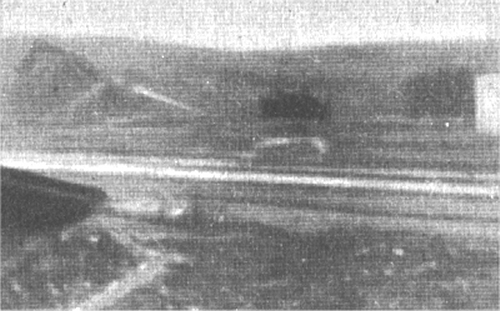
G.I. JOE TAKES AIM 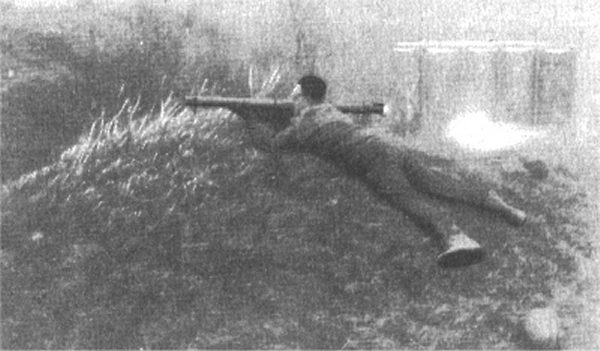
AUF WIEDERSEHEN 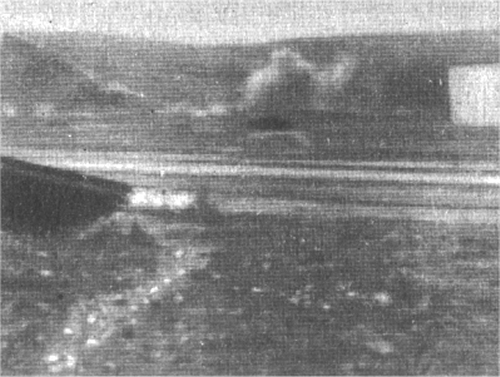
This three act drama occurred near Kalborn when one of our Battalion's crack Bazookamen spotted a Nazi Scout Car approaching a part of the Siegfried Line already taken by elements of the Task Force Commanded by Lieutenant Colonel Albert N. Ward Jr. |
|
"B". Under this new Command, Task Force Ward moved from its assembly area early in the afternoon of the 28th with the mission of spanning the Main River and passing throught the 90th Infantry Division attacking to the North. Muhlheim was the scene of another crossing under a chemical smoke screen as we put the Main River behind us. Vilbel was the next town to be taken after a cross country march to the Nidda River against light, scattered resistance. Capturing the bridge across the Nidda was the springboard for a continued whirlwind assault which took the towns of Massenheim, Erlenbach, Ober-Erlenbach, Dortelweil and Kloppenheim. The first big bag of two hundred prisoners was taken before we closed in bivouac at Ober Erlenbach that night. Task Force Ward moved out again just as a bright sun peeped out over the Rhineland on March 29th, proceeding generally North and alternating between the Autobahn and narrow, dusty roads. Several madly racing armored columns criss-crossing in the same area caused repeated plan and route changes. The enemy's desire for effective resistance was waning, he was far too busy now fleeing or surrendering to the onrushing armor. The thirty five mile advance which skirted Friedberg, Bad Nauheim, Butzbach and Gruningen took the towns of Lich and Hattenrod virtually unopposed. Although it was not the original objective, Hattenrod was outposted because it was here that our Battalion liberated 800 American prisoners of War: German captives since the von Rundstedt breakthrough in Belgium. Whatever doubt might have existed as to the reason for all out warfare against the Nazis was dispeiled that day as stories of treatment by their captors were told by the half starved Americans. Fook [Food] and medical treatment were provided them, and arrangements were made for evacuation of the former prisoners. Meanwhile, handling of enemy prisoners became an almost insurmountable task, due to the fact that every man in a German uniform seemed to be intent on surrending in the face of this lightning like onslaught. Harrassed MP's started for the overflowing PW cages with three or four Krauts under guard, but before reaching their destination picked up hundreds more straggling along every highway. Roads and towns were jammed with the gray clad "Supermen", but still they poured in.
Technician Fifth Grade, R.D. Jones of Service Company was awarded the Silver Star for gallantry in action near Offenbach, Germany on 28 March 1945. When a six man enemy patrol approached the Company's bivouac area shortly before mid-night, he engaged them immediately. His first shot brought down the leader of the enemy group, and when the others dispersed into nearby brush, he advanced across an open road toward them, demanding that they surrender, which they did without delay. In the citation awarding Jones the Silver Star, emphasis is placed on "his outstanding courage and cool desisiveness" [decisiveness] which reflect the highest credit upon himself and upon the military service. Before Task Force Ward moved out of Hattenrod at dawn on March 30 it was strengthened by the addition of one platoon from the Reconnaissance Company of the 603rd Tank Destroyer Battalion. Once again the presence of other friendly armored units caused many detours and delays. Task Force Ward finally managed to get on the Autobahn however, and sped deeper and deeper into Germany. The objective, which had been Kassel, Germany, was suddenly changed, and now we drove toward the City of Leipzig and a junction with the Russian forces then smashing the Nazis from the East. Seventy six miles were covered, and the Task Force closed in bivouac near Neiderbiescheim in the early morning hours on the last day of March. Throughout that day occasional enemy plane attacks were beaten off, but as a whole, enemy resistance was negligible. Although only 30 prisoners were taken, it was a banner day as another large slice had been carved out of Hitler's rapidly disintegrating homeland. The last day of the month provided the stiffest opposition encountered by Task Force Ward since its Prum River campaion. "B" Company moved into Wichte in midmorning, dismounted and entered Neumorschen with the mission of securing a bridgehead across the Fulda River, to permit the continued advance of the Combat Command to the East. With the enemy having the advantage of direct observation for his artillery and self-propelled gun fire, and because of the lack of sufficient infantry strength in the Task Force, Colonel Ward delayed the actual river crossing until after dark. One of the machine gun sections moved up to support "B" Company, while assault guns and mortars of Headquarters Company firing on enemy positions took a heavy toll of enemy personnel and equipment. That night, Task Force Ward withdrew into an assembly area in the vicinity of Wichte, where plans were completed for the crossing of the river on the heels of the 44th Armored Infantry Battalion. "C" Company reverted to Task Force Ward, reaching there at noon. For our Battalion the end of the war was in sight. The entire period had been one long victorious sweep through everything the enemy could offer, in the way of resistance. Remnants of the Luftwaffe, German self-propelled guns, and fanatical last ditch SS troopers had made desperate efforts to stem the tide, but nothing could have stopped the whirlwind onslaught. Our men lost track of time, days merged with night in that final dash to victory. Vast hordes of motley German soldiers wandering aimlessly in all directions, waited to be taken prisoner; confusion with other columns and within the Task Force; drivers falling asleep at the wheel fitful drowsing in crowded, bouncing half tracks; sharp vicious skirmishes when resistance was encountered; refueling on the run; but with it all the sense of victory-these scenes and experiences will forever be etched in the memories of those who raced across Germany with Task Force Ward. April operations began quite inauspiciously as we moved out of Wichte just before noon. Against light opposition the Task Force crossed the Fulda River, enlarged the bridgehead and closed in bivouac near the village of Bergheim that same evening. The following morning, Task Force Ward advanced on another natural water barrier, the Sonta River, but the devastating swiftness of our attack gave the enemy no time to defend. The crossing was quickly forced, and a firm bridgehead established. The third day of April was a day of distinction for our Battalion which, in a rapier like slash that carried us far in front of the flanking units, secured the key to the entire Division's advance. Although the Luftwaffe made another appearance, and a number of scattered enemy pockets were encountered, our sharpshooting veterans met all of these threats and continued the advance. Gross Burchia soon fell to our onrushing column, and with it an all important bridge across the River Werra which had been heavily planted with demolition. The importance of this capture was heightened when the remainder of Combat Command "B" along with Task Forces Brown and Kennedy, followed us across the Werra, after being halted in their sector along the same waterway. Altering the line of advance to the South and East, Task Force Ward moved on through the heavily wooded Muhlhausen Stadtwold meetg [meeting] only scattered resistance. However, much heavier fire was soon encountered, and "C" and "B" companies, plus one tank company deployed to push into Pfafferode, destroying two self propelled guns. Elements of our force then moved in to Oberdorla where our troops took up positions in sectors South and West of Muhlhausen, preparatory For gallantry in action in Germany during, the period from February 6 1945 to April 5, 1945, Lieutenant Colonel Albert N. Ward Jr., Baltimore, Maryland, and Commander of the 50th Armored Infantry Battalion, was awarded the Silver Star. His exceptional leadership ability, brought about the establishment of a Bridgehead on the Pram River, at Lunebach which enabled our Engineers to construct a treadway bridge, over which the entire Sixth Armored Division pressed on deeper into Germany. At Schonecken troops under his Command established another Bridgehead across the Nims River, capturing many prisoners, and seized the town. At another point, Colonel Ward moved his Task Force ahead so rapidly and with such efficiency, that the town of Deleiden was captured before the enemy was aware of the nearness of any American Unit. In each of these instances, operations were carried out under almost constant heavy fire from German positions. His masterful tactical handling of every situation, and inspiring example of great personal courage attained the complete confidence of Officers and Enlisted Men alike. to a Division attack on that City. As was the case in preceding days, enemy air and artillery remained intermittently active, and a sizable bag of prisoners was taken. "B" and "C" companies, each supported by a tank platoon and a machine gun section, moved out at dawn on April 5th to attack Muhlhausen in conjunction with the 9th Armored Infantry Battalion. As the attack developed, four mounted columns passed through the 44th and took Muhlhausen unopposed, with the Burgermeister surrendering on behalf of the population. Enemy air action continued throughout the day and night. Nine ME 109's struck in the Battalion Headquarters area with anti-personnel bombs, causing 15 casualties and damaging two vehicles. Our activity consisted of establishing street patrols and outposts, in addition to guarding vital installations and warehouses, Enormous quantities of supplies were captured. Officials and civilians seemed very cooperative, but considerable trouble was encountered from looters who were soon brought under control. Company "A" rejoined us just as Task Force Ward reverted to Reserve Command. We remained billeted in Muhlhausen performing necessary maintenance work in addition to conducting twenty four hour street patrols and outposts. The short rest period came to an end when the Task Force was alerted for committment at dawn on April 7 which was destined to be filled with some of the wildest actions experienced in our combat history. Task Force Ward moved out of Muhlhausen traveling Northwest with its own Reconnaissance platoon spearheading the column, supported by mortar and Assault Gun platoons of Headquarters Company. Practically all types of enemy resistance were encountered, commencing with a bombing and strafing attack by the Luftwaffe as our troops reached the outskirts of the City. All elements of the column were exposed to direct enemy fire throughout that day, during which many Nazi soldiers could be seen in strength to the front and to our flanks. Although small arms fire and bazooka fire were encountered along the route of march, our column pushed through three small towns, among them Kulestedt where powerful enemy anti-tank fire temporarily stopped us, knocking out the lead tank. Despite that and persistent enemy resistance, Task Force Ward smashed its way Northwest into Wachstedt where it went into bivouac and outposted the town. Besides losing several men killed, the Battalion had two half tracks and a light tank knocked out during the day's operations. The enemy on the other hand lost an estimated 500 men taken prisoner during the advance. The column continued West to Martinfeld, South to Erhausen, then Northwest to Wiesenfeld against generally light enemy resistance. "From Wiesenfeld, Colonel Ward personally led a reconnaissance element to Volkerode; making contact there with the 76th Infantry Division of the First United States Army. A small force consisting of one platoon of tanks and one platoon of infantry was also sent North to Dieterode, and there made contact with Task Force Davall. After all contacts had been made, Task Force Ward was released by the 76th Infantry Division and returned to an assembly area at Wachstedt. Nothing more happened until April 10th when Task Force Ward moved back to Muhlhausen for a brief rest. At 1100 the next day however, Task Force Davall on the Division North flank, with Task Force Ward following, set out with the mission of attacking to the East, securing a bridgehead over the Elbe River and advancing toward Dresden. The advance was swift and resistance negligeble. Bad Teunstedt, Sommerda, Buttstedt and Poppel fell in rapid succession with the last named town 61 miles from the starting point of the day's march. Considerable traffic congestion delayed our next start until the afternoon of the following day. When Lessen was reached, the Combat Command halted and reorganized for a Division attack on Zietz. The Battalion Command Post was established at Meinewey, together with Reserve Command Headquarters. One platoon from "B" Company moved out with orders to attack with Task Force Davall, the Assault Guns of Headquarters Company were attached to the Assault Gun platoon of the 68th Tank Battalion while the balance of Task Force Ward was alerted for possible enemy action. Our Company "C", with Company "A" of the 68th Tank Battalion, reverted to Task Force Davall early in the evening, and one hour later a platoon from "B" Company secured Quesnitz and Kirchsteitz. Company "A" of the 68th rejoined Task Force Ward. Elements of the 76th Infantry Division passed through our positions during the day in the process of establishing a bridgehead across the Weisse Elster River, after a platoon from "B" Company had suceeded in forcing [fording] the river in vehicles. The balance of our force crossed on foot however, and attacked Zeitz against vicious opposition. Time and time again German 88's, laying down deadly direct fire, forced our Engineer bridging section away from their assignment. For gallantry in action in France, Belgium, Luxembourg and Germany, during the period from July 27, 1944 to April 5, 1945, Major Paul C. Root Jr. has been awarded the Silver Star. As the Battalion's Executive Officer, Major Root repeatedly demonstrated aggressive leadership and outstanding efficiency in the face of strong enemy fire. On the Daoulas Peninsula, France, and at Bastogne, Oubourcy and Michamps in Belgium, he constandly [constantly] displayed indominatable will, coolnes [coolness] in danger, and fortitude while coordinating and placing our troops in effective postions for successful action against the enemy. As Battalion Commander, Major Root exemplified the courageous leader, bringing, his Battalion across the Our River into Germany, through the Siegfried Line, and on the dash from Frankfurt am Main, through Alsfeld, Zeigenheim, Homburg and into Mulhausen. His gallant and courageous devotion to duty refelct great credit upon himself and the military Service, which he entered through the United States Military Academy, at West Point New York. When the river was finally crossed, resistance centered around a German Officer Candidate barracks in the southern part of the city. For the first time during the drive the Germans seemed willing to fight it out, and every prisoner taken was literally dragged out by overwhelming force. Finally on the 16th our Battalion disengaged on order from Higher Headquarters when the 76th Infantry Division took over our Positions. A night march which followed immediately to Prehletz met with considerable difficulty occasioned by enemy small arms and bazooka fire as well as confussion [confusion] within the colunm due to the extremly poor visibility. As a result is was not until 4 o'clock on the morning of April 15th that the force halted for a brief rest. |
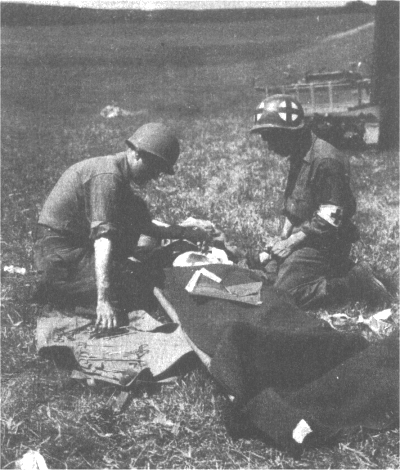
Captain Anthouny Vinci, assisted b y Sergeant Thomas Cardinale, treats member of our Battalionm, wounded ini bitter fighting at Zeitz, German |
|
Clogged road conditions forced our Task force to postpone its advance until early afternoon, but once the column started rolling progress was made enabling us to leave Altenburg, Forst Leina and the Mulda River behind us. Lauenhain became the next assembly area and was reached before dark on April 16th. Company "A" then reverted to Task Force Ward, while attached units went back to their parent organizations. A march of five miles Northwest was accomplished by midafternoon, with "B" Company and the Hq. Co. machine gun platoon moving out immediatly with the mission of clearing Forst Colditz in the vicinity of Rochlitz. Four prisoners were taken and 25 Germans died resisting this mission. After this Skirmish our troops returned to the bivouac area at Klein Milkau early that evening. C Company and the Assault Guns, with one tank platoon, moved in to line early on the morning of the 19th and quickly made contact with the 9th Armored Infantry Battallion on our right, and the the 44th Armored Infantry Battalion on our left. The remainder of the Battalion meanwhile remained in bivouac and was visited by the Red Cross Clubmobile. "B" Company relieved "B" of the 44th that evening and promptly took five prisoners. When "A" Company rejoined the Battalion, no located at Arras, "B" and "C" Companies continued to hold the line, sending aggressive patrols forward. The tedious task of apprehending and checking suspicious looking male civilians began. "B" Company moved to the forward edge of Klostergeringswalde, where they took up new defensive positions alowng with the second platoon of
|
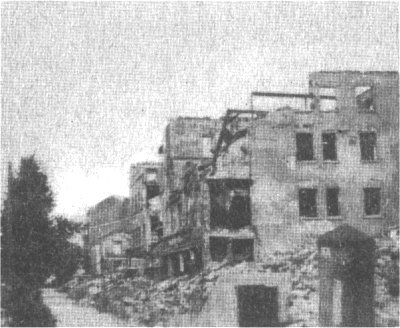
If you remember the terrific artillery barrage laid down near Offenbach, Germany, the above photo shows you the result. |
|
"A" Company. Patrols continued to operate, and some enemy activity was observed. At midnight on April 24 the Battalion moved from Arras, traveling southwest 15 miles to Nidergrafenhain. At this time all attached units were relieved, and the Battalion rested throughout the next two days, April 26 and 27th.
Task Force Ward, which consisted of our entire Battalion, supported by "C" Co. 44th Armored Infantry Battalion as well as the 128th Field Artillery Battalion, moved East to Rochlitz and there relieved the balance of the 44th. Aggresive patrols were sent out but no enemy activity was encountered. |